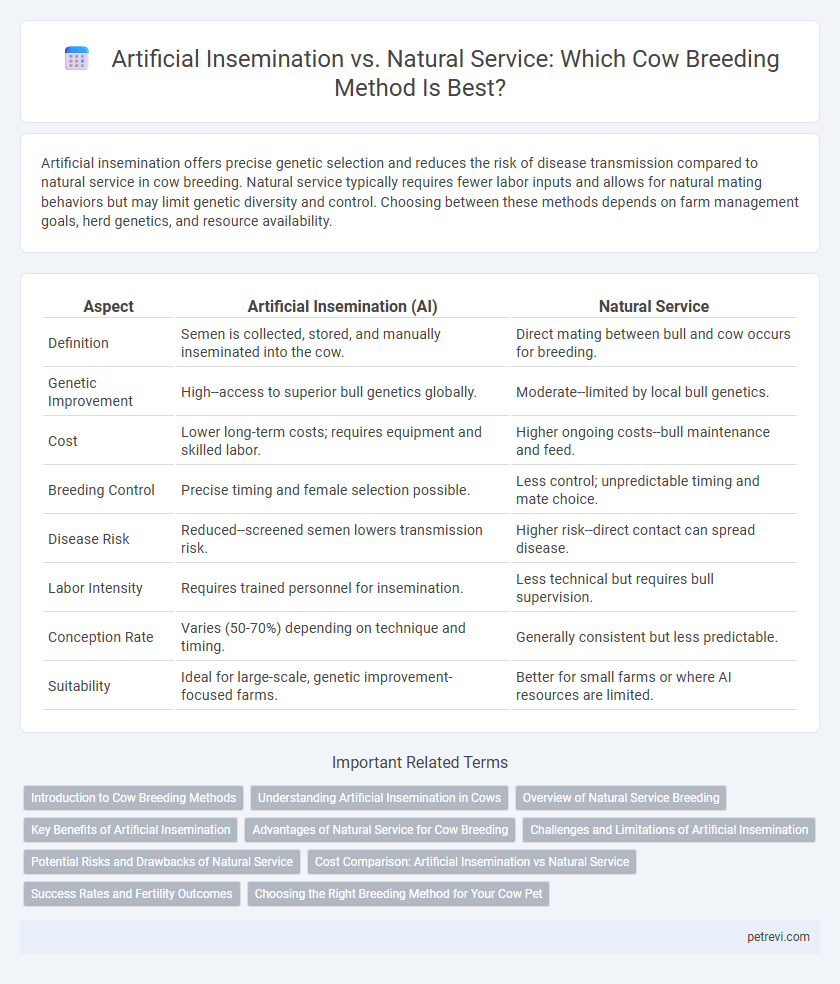Artificial insemination offers precise genetic selection and reduces the risk of disease transmission compared to natural service in cow breeding. Natural service typically requires fewer labor inputs and allows for natural mating behaviors but may limit genetic diversity and control. Choosing between these methods depends on farm management goals, herd genetics, and resource availability.
Table of Comparison
| Aspect | Artificial Insemination (AI) | Natural Service |
|---|---|---|
| Definition | Semen is collected, stored, and manually inseminated into the cow. | Direct mating between bull and cow occurs for breeding. |
| Genetic Improvement | High--access to superior bull genetics globally. | Moderate--limited by local bull genetics. |
| Cost | Lower long-term costs; requires equipment and skilled labor. | Higher ongoing costs--bull maintenance and feed. |
| Breeding Control | Precise timing and female selection possible. | Less control; unpredictable timing and mate choice. |
| Disease Risk | Reduced--screened semen lowers transmission risk. | Higher risk--direct contact can spread disease. |
| Labor Intensity | Requires trained personnel for insemination. | Less technical but requires bull supervision. |
| Conception Rate | Varies (50-70%) depending on technique and timing. | Generally consistent but less predictable. |
| Suitability | Ideal for large-scale, genetic improvement-focused farms. | Better for small farms or where AI resources are limited. |
Introduction to Cow Breeding Methods
Artificial insemination (AI) and natural service are two primary methods used in cow breeding to improve genetic traits and reproductive efficiency. AI allows selective breeding with high-quality semen from superior bulls, increasing genetic diversity without the need for maintaining multiple bulls on-site. Natural service involves direct mating between a bull and cow, often favored for its simplicity and effectiveness in less controlled environments.
Understanding Artificial Insemination in Cows
Artificial insemination (AI) in cows involves the controlled introduction of sperm into the female reproductive tract without natural mating, enhancing genetic diversity and disease control. This technique allows selective breeding from superior bulls, optimizing herd genetics and improving milk and meat production efficiency. Precision in timing and handling ensures higher conception rates compared to conventional natural service methods.
Overview of Natural Service Breeding
Natural service breeding in cows involves direct mating between bulls and cows, leveraging the bull's natural libido and physical ability to detect estrus. This method ensures natural selection and expression of traits, often resulting in higher conception rates under optimal environmental conditions. Despite higher risk of disease transmission and limited genetic diversity, natural service remains preferred in low-input farming systems due to simplicity and low initial cost.
Key Benefits of Artificial Insemination
Artificial insemination in cow breeding offers significant genetic improvement by enabling access to superior bulls worldwide, enhancing herd quality and productivity. It allows for precise timing and control over breeding cycles, increasing conception rates and reducing the spread of sexually transmitted diseases. This method also improves biosecurity, lowers costs related to maintaining bulls, and promotes better herd management through detailed reproductive records.
Advantages of Natural Service for Cow Breeding
Natural service in cow breeding offers advantages such as higher conception rates due to the bull's natural mating behavior and physical stimulation, which enhances fertility. Cows often experience less stress during natural service compared to artificial insemination, leading to improved reproductive performance. Furthermore, natural service requires less technical expertise and equipment, making it a cost-effective option for many cattle operations.
Challenges and Limitations of Artificial Insemination
Artificial insemination in cow breeding faces challenges such as the need for skilled technicians to ensure successful semen handling and deposition. Limitations include lower conception rates in heat detection errors and environmental stressors affecting cow fertility. Unlike natural service, artificial insemination requires significant investment in equipment and timing precision, impacting its efficiency on some farms.
Potential Risks and Drawbacks of Natural Service
Natural service in cow breeding poses potential risks including the transmission of sexually transmitted diseases, such as bovine viral diarrhea and trichomoniasis, which can lead to infertility and pregnancy loss. Physical injuries from aggressive mating behaviors may result in lameness or reproductive tract damage, impacting overall herd health and productivity. Additionally, natural service limits genetic diversity and selection control, potentially reducing herd improvement compared to artificial insemination techniques.
Cost Comparison: Artificial Insemination vs Natural Service
Artificial insemination (AI) in cow breeding typically incurs lower long-term costs due to reduced bull maintenance expenses and higher genetic improvement rates, despite initial investment in semen and equipment. Natural service requires ongoing costs for bull purchase, feeding, housing, and veterinary care, which can escalate annually. AI offers cost efficiency through increased reproductive performance and reduced risk of sexually transmitted infections compared to natural service.
Success Rates and Fertility Outcomes
Artificial insemination (AI) in cow breeding offers precise timing and genetic variety, often resulting in higher success rates and improved fertility outcomes compared to natural service. Studies show AI success rates range from 50% to 70%, attributed to controlled semen quality and synchronized estrus cycles. Natural service, while less technologically demanding, typically results in lower conception rates due to variable bull fertility and breeding timing.
Choosing the Right Breeding Method for Your Cow Pet
Artificial insemination offers precise genetic selection and reduces the risk of disease transmission compared to natural service in cow breeding, enhancing herd quality and productivity. Natural service allows cows to breed with bulls in a more instinctive manner, providing practical advantages in extensive grazing systems but with less control over genetics. Selecting the right breeding method depends on factors such as herd size, genetic goals, management capabilities, and budget constraints.
Artificial Insemination vs Natural Service for Cow Breeding Infographic

 petrevi.com
petrevi.com